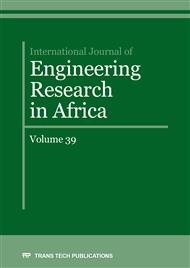[1]
Jin Chen, Quan Wang, Wen Zhong Shen, Xiaoping Pang, Songlin Li, Xiaofeng Guo, Structural optimization study of composite wind turbine blade, Materials and Design, 46 (2013) 247-255.
DOI: 10.1016/j.matdes.2012.10.036
Google Scholar
[2]
C, Kong, J. Bang, Y. Sugiyama, Structural investigation of composite wind turbine blade considering various load cases and fatique life, Energy, 30 (2005) 2101-2114.
DOI: 10.1016/j.energy.2004.08.016
Google Scholar
[3]
F.M. Jensen, B.G. Falzon, J. Ankersen, H. Stang, Structural testing and numerical simulation of a 34m composite wind turbine blade, Composite Structures, 76 (2006) 52-61.
DOI: 10.1016/j.compstruct.2006.06.008
Google Scholar
[4]
Kevin Cox, Andreas Echtermeyer, Structural design and anlysis of a 10MW wind turbine blade," Energy Procedia, 24 (2012) 194-201.
DOI: 10.1016/j.egypro.2012.06.101
Google Scholar
[5]
Thomsen, Ole Thybo, Sandwich materials for wind turbine blades-present and future, Sandwich Structures and Materials, 11 (2009) 7-20.
DOI: 10.1177/1099636208099710
Google Scholar
[6]
Sarp Adali, Viktor E. Verijenko, Minimum cost design of hybrid composite cylinders with temperature dependent properties. composite structures, Composite Structures, 38 (1997) 623-630.
DOI: 10.1016/s0263-8223(97)00100-1
Google Scholar
[7]
Isaa Sfiso Radebe, Sarp Adali, Minimum cost design of hybrid cross-ply cylinders with uncertain material properties subject to external pressure, Ocean Engineering, 38 (2014) 310-317.
DOI: 10.1016/j.oceaneng.2014.06.010
Google Scholar
[8]
P. Coronado, A. Arguelles, J. Vina, V. Mollon, I. Vina, Influence of temperature on a carbon-fibre epoxy composite subjected to static and fatique loading under mode-I delamination, International Journal of Solids and Structures, 49 (2012).
DOI: 10.1016/j.ijsolstr.2012.05.018
Google Scholar
[9]
Rami A. Hawileh, Adi Abu-Obeidah, Jamel A. Abdalla, Adil Al-Tamimi, Temperature effect on mechanical propeties of carbon, glass and carbon-glass FRP laminates, Construction and Building Materials, 75 (2015) 342-348.
DOI: 10.1016/j.conbuildmat.2014.11.020
Google Scholar
[10]
Zhongyu Lu, Guijun Xian, Hui Li, Effects of elevated temperatures on the mechanical properties of basalt fibers and BFRP plates, Construction and Building materials, 127 (2016) 1029-1036.
DOI: 10.1016/j.conbuildmat.2015.10.207
Google Scholar
[11]
Andrew Makeev, Yihong He, Nonlinear shear behavior and interlaminar shear strength of unidirectional polymer matrix composites: A numerical study, International Journal of Solids and Structures, 51 (2014) 1263-1273.
DOI: 10.1016/j.ijsolstr.2013.12.014
Google Scholar
[12]
Yu Bai, Thomas keller, Pultruded GFRP tubes with liquid-cooling system under combined temperature and compressive loading, Composite structures, 90 (2009) 115-121.
DOI: 10.1016/j.compstruct.2009.02.009
Google Scholar
[13]
E.C. Botelho, L.C. Pardini, M.C. Rezende, Hygrothermal effects on the shear properties of carbon fiber/epoxy composites, J. Mater Sci , 41 (2006) 7111-7118.
DOI: 10.1007/s10853-006-0933-7
Google Scholar
[14]
Ray. B.C, Temperature effect during humid ageing on interfaces of glass and carbon fibers reinforced epoxy composites, Journal of Colloid and Interface Science, 298 (2006) 111-117.
DOI: 10.1016/j.jcis.2005.12.023
Google Scholar
[15]
P.J. Herrera-Franco, L.T. Drzal, Comparison of methods for the measurement of fibre/matrix adhesion in composites, Composite, 23 (1992) 2-26.
DOI: 10.1016/0010-4361(92)90282-y
Google Scholar
[16]
Kenneth J. Bowles, Stephen Frimpong, Void Effects on the Interlaminar Shear Strength of Unidirectional Graphite-Fiber-Reinforced Composites, Journal of Composite Materials, 26 (1992) 1487-1509.
DOI: 10.1177/002199839202601006
Google Scholar
[17]
F. Rosselli, M.H. Santare, Comparison of the short beam shear (SBS) and interlaminar shear device (ISD) tests, Composites Part A , 28A (1997) 587-594.
DOI: 10.1016/s1359-835x(97)00009-2
Google Scholar
[18]
Zhihang Fan, Michael H. Santare, Suresh G. Advani, Interlaminar shear strenght of glass fiber reinforced epoxy composites enhanced with multi-walled carbon nanotubes, composites: part A 39 (2008) 540-554.
DOI: 10.1016/j.compositesa.2007.11.013
Google Scholar
[19]
Madtw S. Madhukar, Lawrence T. Drzal, Fiber-Matrix Adhesion and Its Effect on Composite Mechanical Properties: I. Inplane and Interlaminar Shear Behavior of Graphite/Epoxy Composites, Journal of Composite Materials, 25 (1991) 932-957.
DOI: 10.1177/002199839102500801
Google Scholar
[20]
Michelle Leali Costaa, Sergio Frascino M. de Almeidaa, Mirabel Cerqueira Rezendeb, The influence of porosity on the interlaminar shear strength of carbon/epoxy and carbon/bismaleimide fabric laminates, Composites Science and Technology, 61(2001).
DOI: 10.1016/s0266-3538(01)00157-9
Google Scholar
[21]
N. Saba, M. Jawaid, Othman Y. Alothman, M.T. Paridah, A review on dynamic mechanical properties of natural fibre reinforced polymer composites, Construction and Building Materials, 106 (2016) 149-159.
DOI: 10.1016/j.conbuildmat.2015.12.075
Google Scholar
[22]
S.N. Goyanes, P.G. Konig, J.D. Marconi, Dynamic Mechanical Analysis of Particulate-Filled Epoxy Resin, Journal of Applied Polymer Science, 88 (2013) 883-892.
DOI: 10.1002/app.11678
Google Scholar
[23]
W.K. Goertzen, M.R. Kessler, Dynamic mechanical analysis of carbon/epoxy composites for structural pipeline repair, Composites Part B: 38 (2007) 1-9.
DOI: 10.1016/j.compositesb.2006.06.002
Google Scholar
[24]
R. Murugan, R. Ramesh, K. Padmanabhanc, Investigation on Static and Dynamic Mechanical Properties of Epoxy Based Woven Fabric Glass/Carbon Hybrid Composite Laminates, Procedia Engineering , 97 (2014) 459-468.
DOI: 10.1016/j.proeng.2014.12.270
Google Scholar
[25]
ASTM standard D 3171, Standard test method for matrix digestion, United States of America, (1999).
Google Scholar
[26]
J. A Quinn, Composites - Design Manual, Liverpool, L25 4SY, England, (2002).
Google Scholar
[27]
G. Odegard, M. Kumosa, Elastic-plastic and failure properties of a unidrectional carbon/PMR-15 composite at room and elevated temperatures, Composites Science and Technology, 60 (2000) 2979-2988.
DOI: 10.1016/s0266-3538(00)00163-9
Google Scholar
[28]
M. Jawaid, H.P.S. Abdul Khalil, Omar S. Alattas, Woven hybrid biocomposites: Dynamic mechanical and thermal properies, Composites: Part A, 43 (2012) 288-293.
DOI: 10.1016/j.compositesa.2011.11.001
Google Scholar
[29]
Ferry JD, Viscoelastic properies of polymers, New York, John Wiley and Sons, inc:.(1980).
Google Scholar
[30]
Yu Bai, Thomas Keller, Till Vallee, Modeling of stiffness of FRP composites under elevated tempratures, Composites Science and Technology, 68 (2008) 3099-3106.
DOI: 10.1016/j.compscitech.2008.07.005
Google Scholar
[31]
A.G. Gibson, Y.S. Wu, J.T. Evans, Laminate theory analysis of composites under load in fire, Journal of Composite Materials, 40 (2006) 639-659.
DOI: 10.1177/0021998305055543
Google Scholar


